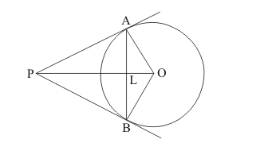From a point P, two tangents PA and PB are drawn to a circle with centre O. If OP = diameter of the circle, show that Δ APB is equilateral.
Let us first put the given data in the form of a diagram.

Consider ![]() and
and![]() . We have,
. We have,
PO is the common side for both the triangles.
PA = PB(Tangents drawn from an external point will be equal in length)
OB = OA(Radii of the same circle)
Therefore, by SSS postulate of congruency, we have
$\triangle \mathrm{POA} \cong \triangle \mathrm{POB}$
Hence,
$\angle O P A=\angle O P B$............(1)
Now let us consider $\triangle P L A$ and $\triangle P L B$. We have,
PL is the common side for both the triangles.
![]() (From equation (1))
(From equation (1))
PA = PB (Tangents drawn from an external point will be equal in length)
From SAS postulate of congruent triangles,
![]()
Therefore,
PL = LB …… (2)
$\angle P L A=\angle P L B$
Since AB is a straight line,
$\angle A L B=180^{\circ}$
$\angle P L A+\angle P L B=180^{\circ}$
$2 \angle P L A=180^{\circ}$
$\angle P L A=90^{\circ}$
$\angle P L B=90^{\circ}$
Let us now take up ΔOPB. We know that the radius of a circle will always be perpendicular to the tangent at the point of contact. Therefore,
$\angle O B P=90^{\circ}$
By Pythagoras theorem we have,
$P B^{2}=O P^{2}-O B^{2}$
By Pythagoras theorem we have,
$P B^{2}=O P^{2}-O B^{2}$
It is given that
OP = diameter of the circle
Therefore,
OP = 2OB
Hence,
$P B^{2}=(2 O B)^{2}-O B^{2}$
$P B^{2}=4 O B^{2}-O B^{2}$
$P B^{2}=3 O B^{2}$
$P B=\sqrt{3} O B$
Consider $\triangle P L B$. We have,
$L B^{2}=P B^{2}-P L^{2}$
But we have found that,
$P B=\sqrt{3} O B$
Also from the figure, we can sayPL = PO − OL
Therefore,
$L B^{2}=3 O B^{2}-[P O-O L]^{2} \ldots \ldots(3)$
Also, from ![]() , we have
, we have
$L B^{2}=O B^{2}-O L^{2}$
Since Left Hand Sides of equation (3) and equation (4) are same, we can equate the Right Hand Sides of the two equations. Thus we have,
$O B^{2}-O L^{2}=3 O B^{2}-[P O-O L]^{2}$
$O B^{2}-O L^{2}=3 O B^{2}-\left[P O^{2}+O L^{2}-2 . P O . O L\right]$
$O B^{2}-O L^{2}=3 O B^{2}-P O^{2}-O L^{2}+2 . P O . O L$
We know from the given data, that OP = 2.OB. Let us substitute 2OB in place of PO in the above equation. We get,
$O B^{2}-O L^{2}=3 O B^{2}-(2 O B)^{2}-O L^{2}+2.2 . O B . O L$
$O B^{2}-O L^{2}=3 O B^{2}-4 O B^{2}-O L^{2}+4 . O B . O L$
$2 O B^{2}=4 . O B . O L$
$O L=\frac{O B}{2}$
Substituting the value of OL and also PO in equation (3), we get,
$L B^{2}=3 O B^{2}-\left[2 O B-\left(\frac{O B}{2}\right)\right]^{2}$
$L B^{2}=3 O B^{2}-\left[4 O B^{2}+\left(\frac{O B^{2}}{4}\right)-2 . O B^{2}\right]$
$L B^{2}=3 O B^{2}-4 O B^{2}-\left(\frac{O B^{2}}{4}\right)+2 . O B^{2}$
$L B^{2}=\frac{3 O B^{2}}{4}$
$L B=\frac{\sqrt{3} O B}{2}$
Also from the figure we get,
AB = PL + LB
From equation (2), we know that PL = LB. Therefore,
AB = 2.LB
$A B=2 \times \frac{\sqrt{3} O B}{2}$
$A B=\sqrt{3} O B$
We have also found that![]() . We know that tangents drawn from an external point will be equal in length. Therefore, we have
. We know that tangents drawn from an external point will be equal in length. Therefore, we have
PA = PB
Hence,
PA = ![]()
Now, consider ![]() . We have,
. We have,
PA = ![]()
PB = ![]()
AB = ![]()
Since all the sides of the triangle are of equal length, ![]() is an equilateral triangle. Thus we have proved.
is an equilateral triangle. Thus we have proved.
